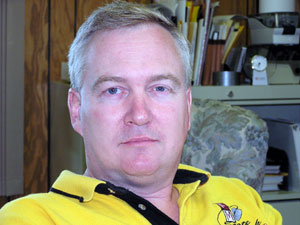|
Photos
Resources
Your Voice
|
Sewer problems threaten growth in small towns
October 6, 2004
 |
| New York Mills Mayor Randy Clarksean says because of the city's aging sewer system, it's difficult to attract new businesses to his city. (MPR Photo/Bob Reha) |
New York Mills, Minn. — New York Mills is a quiet little town in west central Minnesota. About 800 people call it home. The main street hosts a café and bakery, and there's a popular bed and breakfast here.
It's a nice quiet town, with affordable housing. It's an attractive place for people commuting to nearby Perham or Fergus Falls. But Mayor Randy Clarksean says New York Mills is in a tough spot, because it can't capitalize on its potential.
"The Minnesota Pollution Control Agency has limited us to another eight homes that can be added to our system," says Clarksean. "Which means if we want to expand or grow as a community, we're stuck."
 | |||
That's because the sewer system can't handle new development. The town needs $3.7 million to replace its sewers. But despite that need, no one is in favor of an increase in water and sewer costs.
New York Mills has an aging population, with many residents on fixed incomes. Property values are low. Mayor Clarksean says because of the aging infrastructure, it's difficult to get any business to consider New York Mills as a potential home.
"We would be hard-pressed to make a good sales pitch to a company that wants to come in and process agricultural products that would be a heavy water-use industry," says Clarksean.
Clarksean says there haven't been any pollution problems because of the sewer system. But as the system gets older, the risk of leaks or a collapse increases. If such a problem occurrs, local lakes could be contaminated.
New York Mills is not unique in facing problems from aging sewer and water systems. The West Central Initiative, a non-profit group that works with rural communities to develop economic plans, has studied the situation. Nancy Straw, the group's president, says many cities and towns in the area have sewer systems that are at least 50 years old.
"We found that just in our nine counties alone, we had a need of $472 million worth of work that is needed within the next two years," says Straw.
|
The MPCA has limited us to another eight homes that can be added to our system, which means if we want to expand or grow as a community, we're stuck.
- New York Mills Mayor Randy Clarksean |
Straw says of the towns surveyed, 57 have a population of 600 people or less. Straw says some communities are looking for the state to help pay the cost, but a statewide fund set up for that purpose has just $30 million available.
"Thirty million wouldn't go very far even in our nine counties, so all across the state it's just a small portion of it," says Straw. "There are also a lot of communities that can afford to pay. Once a community gets to about 3,000 in population, they typically can self-finance whatever they need -- it doesn't become as big an issue."
Straw says communities of 3,000 people or more have a big enough tax base, so usually they can raise the money needed to replace or fix their sewer systems. But, there are only eight cities that big in the nine counties surveyed.
Battle Lake, Minnesota, a city of 800, just completed a $4.5 million overhaul of its sewer system.
City Clerk Wanda Berg-Vorgert says Battle Lake's economy has changed over the years. It's gone from being dependent on agriculture to tourism. She says it's changing once again. "Our economic development is in establishing residential lots and building homes," says Berg-Vorger. "In the last two-and-a-half years, we've had 22 new housing starts, which I think is phenomenal for a city this size."
Berg-Vorgert says the homes aren't just lake cabins or retirement homes. She says census figures show Battle Lake is bucking a trend. Young people are moving to the town and they're staying.
Berg-Vorgert says Battle Lake is ahead of many small towns, because it's been able to expand its tax base and raise the money for needed repairs. Berg-Vorgert says the city is planning for the future. Now, part of the money collected from water and sewer bills is set aside for the day when the new system wears out.
|
News Headlines
|
Related Subjects
|
